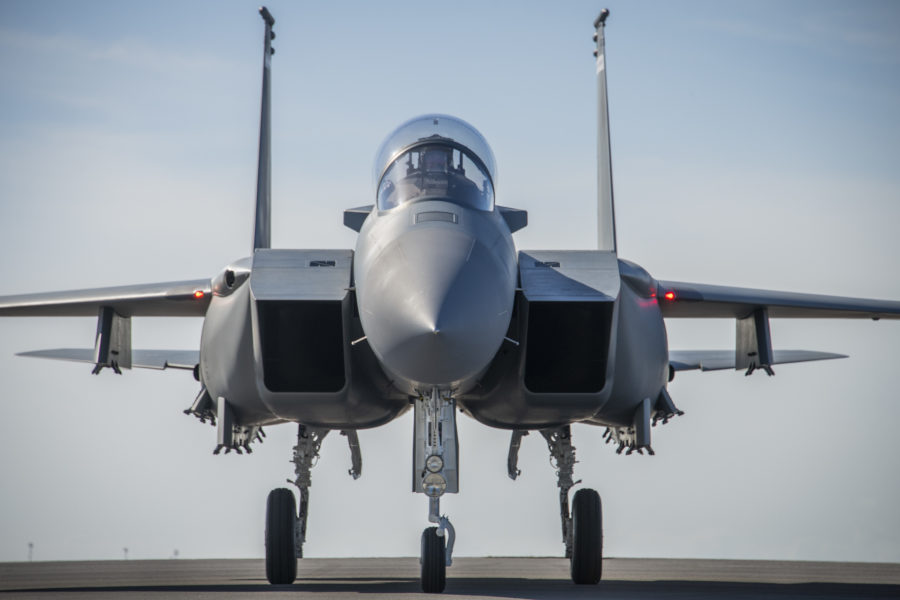The Air Force unveiled the name of its newest fighter jet—the F-15EX Eagle II—during an April 7 ceremony at Eglin Air Force Base, Fla.
ANG Director Lt. Gen. Michael A. Loh said during the ceremony the F-15EX’s improvements will be key to its mission of homeland defense. The Air National Guard will be the first to receive the new jet operationally.
“The Air National Guard flies 93 percent of homeland defense missions, and along with the F-35A, the F-15EX will help ensure that legacy for many decades to come,” he said. “These brand-new aircraft represent a significant upgrade over the legacy F-15C. A significant upgrade in weapons capacity, including the ability to carry outsize weapons, for these missions and for stand-off roles in the high-end fight.”
The Air Force accepted the first F-15EX on March 10, and it was delivered to the 96th Test Wing at Eglin one day later. The second F-15EX is expected to be delivered to Eglin in the coming weeks, according to Air Combat Command.
Air Force Materiel Command owns the first jet, which is being used for developmental testing, while ACC will own the second F-15EX and use it for operational testing.
“The EX provides a unique opportunity for our test enterprise, as well as the first Air Force aircraft to be completely tested and fielded through combined developmental and operational test,” said Brig. Gen. Scott A. Cain, 96th Test Wing commander, during the ceremony. “This cooperative effort will ensure a rigorous test process that accomplishes rapid delivery to the warfighter.”
USAF plans to buy 144 F-15EXs over 10 to 12 years as its older F-15C/D ages out. The first production lot includes six aircraft, to be delivered in fiscal 2023. Subsequent lots will be delivered to the F-15 schoolhouse at Kingsley Field, Ore., and the first operational base at Portland International Airport, Ore.
Lt. Gen. Duke Z. Richardson, the military deputy in the Office of the Assistant Secretary of the Air Force for Acquisition, Technology, and Logistics, said during the ceremony that the F-15EX is designed to take advantage of recent advancements in F-15 development funded by foreign partners, and new approaches in digital engineering to speed up the acquisition timeline. The two F-15EXs will be delivered within nine months of the contract award, as opposed to the normal 39 months, Richardson said.
Recent F-15 FMS sales produced digital engineering models for the EX’s nose barrel and wings, with USAF also funding the digital engineering of the jet’s fuselage. The jet is designed with an open mission systems architecture, along with a high speed fiber optics avionics service bus to allow for new, advanced avionics systems to be installed quickly, Richardson said.
“With its large weapons capacity, digital backbone, and open architecture, the F-15EX will be a key element of our tactical fighter fleet and complement fifth-generation assets for decades to come.”
Since the F-15EX is so similar to the existing F-15 fleet, the Air Force is able to use existing infrastructure to “rapidly transition to F-15EX operations and maintenance” and reduce overall schedule risk, Richardson said.
Quick adoption of the F-15EX is needed because of the state of the current F-15C/D fleet, Richardson said. Ten percent of the fleet is grounded due to structural issues, with 75 percent flying beyond their certified service life, he said. The fleet has an average age of 37 years, and a life extension is “cost prohibitive,” he said.
“Undefeated in aerial combat, the F-15 Eagle epitomized air superiority in the minds of our adversaries, allies, and the American people for over 45 years,” he said. “But it was not meant to fly forever. The F-15C and D fleets, in their current state, places us at great risk.”
Editor’s Note: This story was updated with more information from the ceremony at 8:53 p.m. on April 7.

